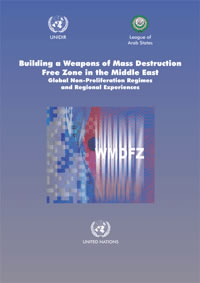The Middle East, for over half a century, has been confronted with an insoluble dilemma: the threat posed by the existence of weapons of mass destruction (WMD) in this volatile region. Proposals to create a zone free of nuclear weapons and other WMD in the Middle East were important attempts at tackling these concerns on a regional basis. Egypt and Iran first proposed a Middle Eastern Nuclear-Weapon-Free Zone in 1974 at the First Committee of the UN General Assembly. In April 1990 Egypt took the idea a step further, proposing the creation of a Weapons of Mass Destruction Free Zone (WMDFZ) in the Middle East to include nuclear, chemical and biological weapons.
Efforts to create a WMDFZ, such as the relevant aspects of Security Council Resolution 687 (1991) and the 1995 NPT Review and Extension Conference decision to pursue a nuclear-free zone in the region, have not been sustained. The result? The Middle East seems no closer to realizing the aims of a WMDFZ than it was thirty years ago nor is the region any safer. It is evident that Arab and Israeli security requirements and threat perceptions remain far apart. Deep mistrust has only lent itself to the self-perpetuating cycle of WMD proliferation, hence creating even more insecurity.
In response to the need for regional arms control and disarmament, the League of Arab States and UNIDIR held a conference in Cairo on "Building a WMD Free Zone in the Middle East: Global Non-Proliferation Regimes and Regional Experiences" on 24–25 February 2003. This volume is an edited collection of the papers presented at the conference.
Citation: Vilmos Cserveny et al. (2004). "Building a Weapons of Mass Destruction Free Zone in the Middle East: Global Non-Proliferation Regimes and Regional Experiences", UNIDIR, Geneva.
